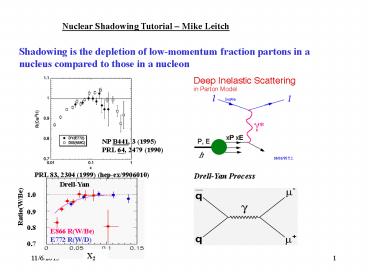Nuclear Shadowing Tutorial PowerPoint PPT Presentation
1 / 10
Title: Nuclear Shadowing Tutorial
1
Nuclear Shadowing Tutorial Mike Leitch
Shadowing is the depletion of low-momentum
fraction partons in a nucleus compared to those
in a nucleon
NP B441, 3 (1995) PRL 64, 2479 (1990)
PRL 83, 2304 (1999) (hep-ex/9906010)
2
Nuclear Dependence for J/Ys
NA3 200 GeV
E866 800 GeV
E866/NuSea 800 GeV p-A (Fermilab) PRL 84, 3256
(2000) (nucl-ex/9909007)
3
Shadowing from the uncertainty principle
- small momentum quarks and gluons, because of
the uncertainty principle, spread over a distance
comparable to the nucleon-nucleon separation.
Quarks and gluons from different nucleons can
overlap spatially and fuse, thus increasing the
density of high momentum partons anti-shadowing
at the expense of that of lower momentum ones
shadowing - Arneodo, Phys. Rep. 240, 301 (1994)
- Nicolaev Zakharov Phys. Lett 55B, 397 (1975)
- Mueller Qiu, Nucl. Phys. B268, 427 (1986)
Size of parton from uncertainty principle
Nucleon separation
Resulting x region for shadowing
4
Shadowing as a black-disk phenomena
- This is where the term shadowing comes from,
e.g. from photon interactions with nuclei, where
in the vector-dominance model the photon
fluctuates into vector meson states which
interact strongly with the nucleus which
therefore appears black and causes cross sections
to go as the surface area or A2/3 - M. Arneodo, Phys. Rep. 240, 301 (1994)
- If the longitudinal momentum is such that the
coherence length is longer than the mean
internucleon separation of nucleons in a nucleus
then the scattering off these nucleons is
coherent and destructively interferes resulting
in the nucleons after the first effectively not
being seen by the incident parton - Johnson, Kopeliovich et al, Phys. Rev. C65,
025203 (hep-ph/0105195) - Kopeliovich, Tarasov, Hufner hep-ph/0104256
- coherence length is the maximal longitudinal
distance between fluctuations that are in phase
5
Empirical approaches to shadowing global fits
- Global fit to all available data - mainly
deep-inelastic scattering data, but also
Drell-Yan. Gluon modification from Q2 evolution
of DIS data. - Eskola, Kolhinen Vogt, Nucl.Phys. A696 729
(2001) (hep-ph/0104124) - Eskola, Kolhinen Ruuskanen, Nucl.Phys. B535
351 (1998) (hep-ph/9802350)
6
Other approaches to shadowing
- broken nucleons- i.e. modification
- of the projectile, i.e. proton in p-A
- Hwa, Lesniak, PL B295, 11 (1992)
- global c2 fits to DIS, DY data
- Hirai, Kumano, Miyama, hep-ph/0103208
- shadowing approach similar Kopeliovich
- Gerland, Frankfurt, Strikman et al,
- nucl-th/0009008
Gluon shadowing Gerland, Frankfurt,
Strikman, Stocker Greiner (hep-ph/9812322)
7
Competition between shadowing and energy loss
- E866/NuSea 800 GeV Drell-Yan analysis using
Eskola shadowing - PRL 83, 2304 (1999) (hep-ex/9906010)
- No quark energy loss indicated, Eskola shadowing
explains essentially all observed suppression - but Eskola shadowing had already fit E772
Drell-Yan data, so may be including energy loss
as shadowing circular logic - Later analysis using Kopeliovich approach
- PRL 86, 4483 (2001) PRC 65, 025203
(hep-ex/0010051 hep-ph/0105195) - explicit shadowing calculation in the
color-dipole model explains only part of
suppression and leads to energy loss of 2.73 ?
0.37 ? 0.5 GeV/fm - shadowing and energy loss separated by 2D, mass
vrs x1, analysis where shadowing vanishes at
large mass (see next pg.) - Another analysis from Arleo hep-ph/0201066
- also uses low-energy (150 280 GeV) NA3
Drell-Yan p--A data where shadowing should be
small - but uncertainties of NA3 data are very large
- Future E906 Exp at Fermilab 120 GeV Main
Injector would do a high-statistics measurement
at lower energy where shadowing is out of the way
and energy loss can be measured. See
http//p25ext.lanl.gov/e866/papers/p906/proposal_f
inal.ps
8
Parton Energy Loss in Nuclei Kopeliovich Model
Johnson, Kopeliovich et al., hep-ph/0105195
Shadowing
dE/dx Shadowing
Drell-Yan data from E772 (PRL 64, 2479 (1990))
9
Gluon Shadowing for J/?s
Eskola, Kolhinen, Vogt hep-ph/0104124
PHENIX µ PHENIX e E866 (mid-rapidity) NA50
Kopeliovich, Tarasov, Hufner hep-ph/0104256
x2
- Shadowing in PHENIX µµ- acceptance for d-Au
collisions very uncertain from models? - Eskola 0.8
- Kopeliovich 0.4
- Strikman hep-ph/9812322 0.4
PHENIX µµ- (Au)
10
Gluon Shadowing - Largely Unknown
- Gluon shadowing for J/? -gt µµ- in PHENIX?
- Eskola et al. hep-ph/0104124 0.8
- Kopeliovich et al. hep-ph/0104256 0.4
- Need to measure it in d-Au collisions
- x2 is the momentum fraction of the target
nucleon that a parton (quark or gluon) carries - xF is fraction of maximum CM momentum,
- i.e. how fast is it (e.g. a J/Y) going

